Introduction
A sunny day at the pool, kids splashing with joy—there’s nothing more heartwarming! But beneath the laughter lies a critical skill every child needs: learning to swim. Teaching kids to swim isn’t just about fun; it’s a life-saving skill that builds confidence, safety, and independence. In this guide, you’ll discover how to teach kids to swim effectively, from water safety basics to playful techniques that turn lessons into adventures. Let’s dive in!
Why Swimming is a Life Skill Every Child Should Learn?
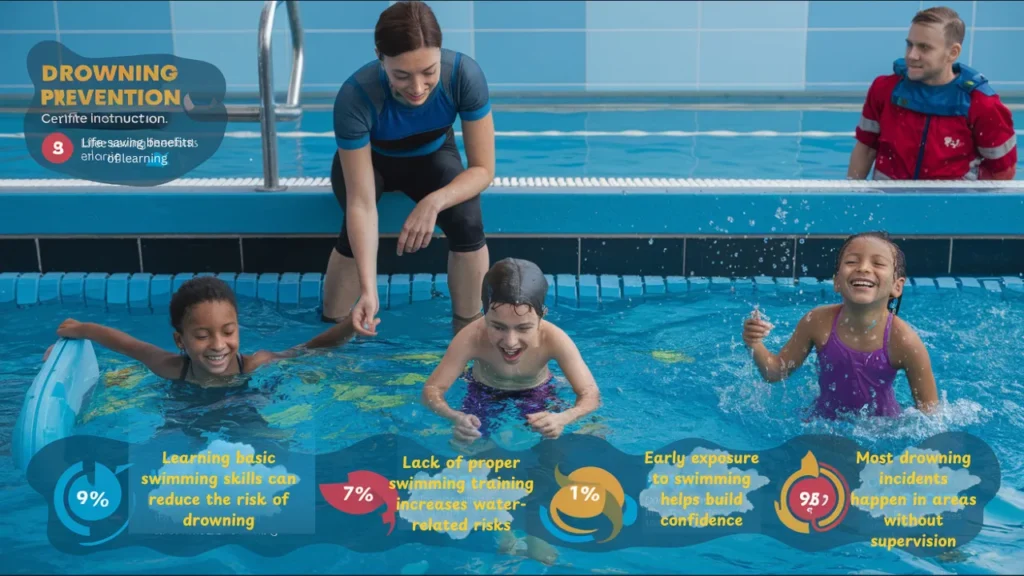
- Drowning Prevention: Share sobering statistics about childhood drowning (e.g., “Drowning is the leading cause of accidental death for children under 5”).
- Life-Saving Skill: Explain how swimming can save lives and reduce the risk of water-related accidents.
- Physical and Mental Benefits: Discuss how swimming improves physical fitness, coordination, and confidence.
- Social and Fun Aspect: Mention how swimming is a great way for kids to socialize and enjoy outdoor activities.
When is the right time to teach kids to swim with lessons?

- Ideal Age: Explain that kids can start as early as 6 months with parent-child classes, but formal lessons often begin around 4 years old.
- Signs of Readiness: Look for curiosity about water, comfort in the bathtub, and basic motor skills.
- Water Familiarity: Emphasize the importance of introducing kids to water early, even if it’s just splashing in a kiddie pool.
Fun Ways to Introduce Your Child to Water
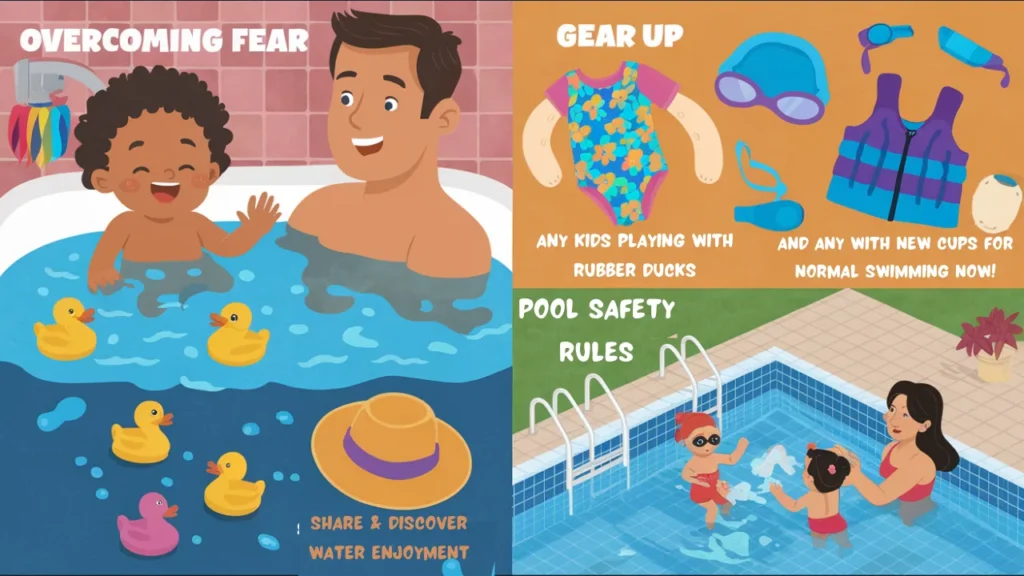
- Overcoming Fear: Share tips for helping kids feel comfortable in the water, like playing with water toys or singing songs during bath time.
- Gear Up: List essential items (e.g., swimsuits, goggles, floatation devices) and explain their importance.
- Parental Role: Discuss how parents should model confidence and calmness around water to set a positive example.
- Start Small: Suggest starting in shallow water or a kiddie pool before moving to deeper areas.
Water Safety Rules Every Parent Should Know
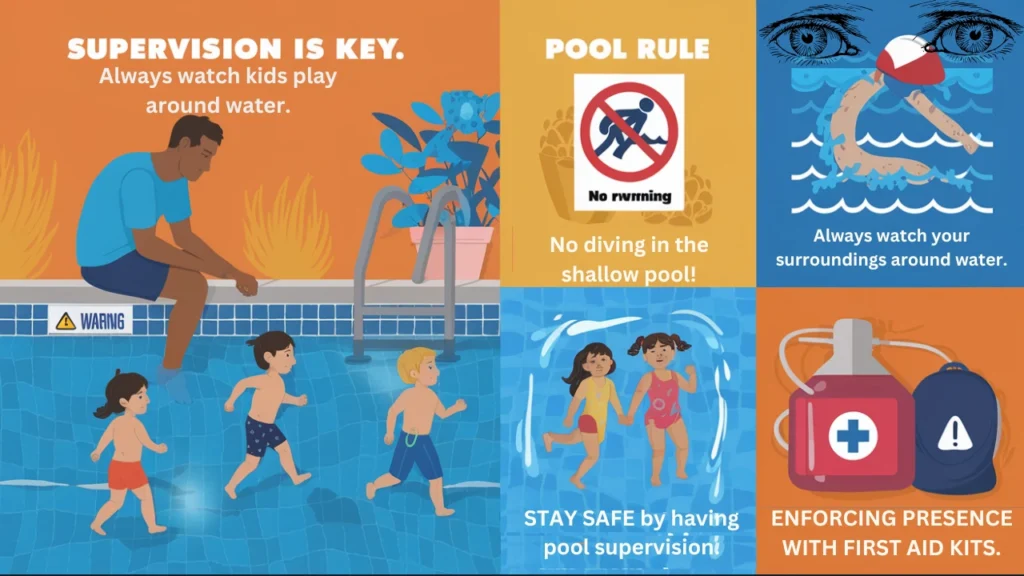
- Supervision is Key: Stress the importance of constant adult supervision, even if kids know how to swim.
- Pool Rules: Teach kids basic rules like “no running near the pool,” “no diving in shallow water,” and “always swim with a buddy.”
- Emergency Preparedness: Explain how to call for help and what to do if someone is in trouble in the water.
- Floatation Devices: Discuss the proper use of life jackets and floaties, but emphasize that they’re not a substitute for supervision.
Step-by-step guide to teach kids to swim and master the basics.
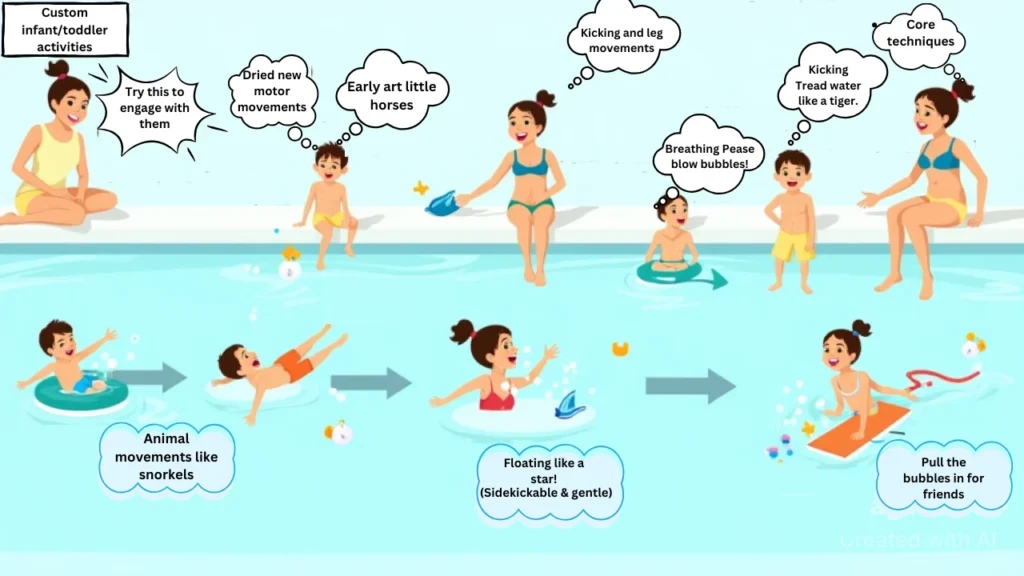
- Getting Comfortable in the Water
- Play games like “blowing bubbles” or “pretend to be a fish” to help kids relax.
- Use toys or floating objects to encourage exploration.
- Floating
- Teach back floating first, as it’s easier for beginners.
- Support your child’s head and body until they feel confident.
- Kicking and Leg Movements
- Have kids hold onto the pool edge or a floatation device while practicing kicking.
- Incorporate playful cues such as “kick like a mermaid” or “imagine you’re riding a bike.”
- Arm Movements and Strokes
- Start with simple arm movements, like the doggy paddle.
- Gradually introduce basic strokes like freestyle.
- Breathing Techniques
- Teach kids to turn their head to the side to breathe while swimming.
- Practice blowing bubbles in the water to build breath control.
- Putting It All Together
- Combine kicking, arm movements, and breathing for basic swimming.
- Celebrate small milestones to keep kids motivated.
Fun Games and Activities to Teach Swimming

- Treasure Hunt: Toss sinking toys into the pool and have kids retrieve them.
- Simon Says: Play “Simon Says” with commands like “Simon says kick your legs” or “Simon says blow bubbles.”
- Pool Noodle Races: Have kids race across the pool using pool noodles for support.
- Underwater Challenges: Encourage kids to open their eyes underwater or count how many seconds they can stay submerged.
Tips for Parents Teaching Kids to Swim
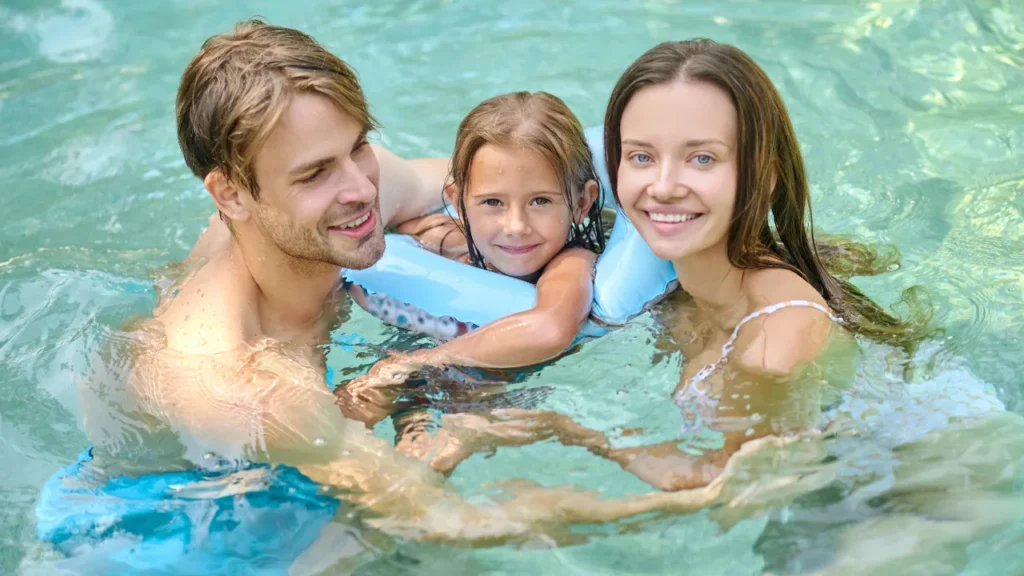
- Be Patient: Every child learns at their own pace, so avoid rushing or pressuring them.
- Stay Positive: Use encouragement and praise to build confidence.
- Make It Fun: Keep lessons short and enjoyable to maintain interest.
- Know Your Limits: If you’re not confident in your teaching skills, consider enrolling your child in professional swim lessons.
Advanced Skills and Next Steps

- Treading Water: Teach kids to stay afloat by moving their arms and legs in a circular motion.
- Diving: Introduce diving in shallow water once kids are comfortable with swimming basics.
- Different Strokes: Gradually teach advanced strokes like backstroke, breaststroke, and butterfly.
- Regular Practice: Encourage kids to swim regularly to build endurance and refine their skills.
Conclusion
Teaching kids to swim is one of the greatest gifts you can give them—it’s fun, empowering, and lifesaving. With patience, playful methods, and a focus on safety, you’ll watch your little one glide from nervous splashes to confident strokes. Ready to start? Grab those goggles, hit the pool, and remember: every splash is a step toward lifelong confidence!
Struggling with shoelaces? Try the easiest way to teach kids to tie shoes.
Engage toddlers with the top storybooks for young readers.
FAQs: Teaching Kids to Swim
Are group lessons better?
Group classes add fun, but 1-on-1 time builds trust.
What if my child hates water?
Start slow! Use toys and never force them.
Do floaties help?
Yes, but pair them with active teaching—floaties aren’t a substitute for skills.
How long until they swim solo?
Most kids need 6–12 months of weekly practice.
Should I teach my child to swim myself, or hire a professional?
If you’re confident in your swimming and teaching skills, you can start with basic lessons at home. However, to Teach Kids to Swim effectively—especially if they’re hesitant or need advanced techniques—consider professional swim lessons. Certified instructors are trained to teach kids safely and efficiently.”
Books for Parents and Kids

- “Teach Your Kids to Swim: Tips and Tricks for Fun-for-Everyone Swimming Lessons” by Karen Murphy
- A practical guide for parents teaching kids to swim, with step-by-step instructions and fun activities.
- “Swim Float Swim: A Step-by-Step Guide to Teaching Your Child to Swim” by Jan Emler
- Focuses on water safety and self-rescue techniques for young children.
- “The Little Otter: A Story to Help Kids Overcome Their Fear of Water” by Artie Knapp
- A children’s book that helps kids feel more comfortable and confident in the water.
- “Water Safety with Swimmy” by Carolanne Caron
- A fun, educational book for kids that teaches water safety rules through a friendly fish character.
Videos and Online Resources
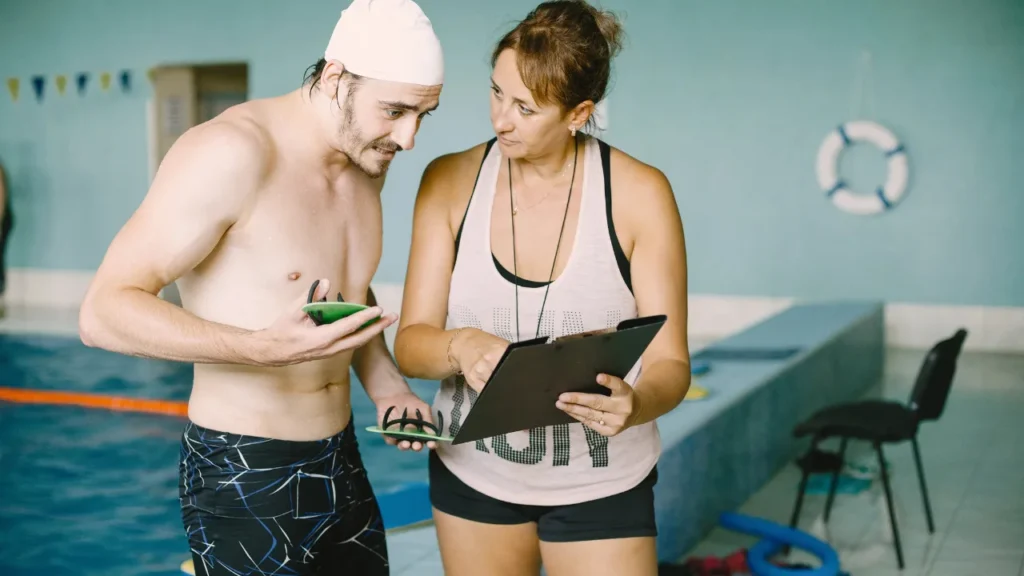
- YouTube Channel: SwimtoFly
- Offers free video tutorials for teaching kids to swim, from basic skills to advanced strokes.
Link: https://www.youtube.com/user/SwimtoFly
- Offers free video tutorials for teaching kids to swim, from basic skills to advanced strokes.
- YouTube Channel: Swim Lessons University
- Features instructional videos for parents and swim instructors, focusing on water safety and teaching techniques.
Link: https://www.youtube.com/user/SwimLessonsUniversity
- Features instructional videos for parents and swim instructors, focusing on water safety and teaching techniques.
- Red Cross Swim App
- A free app with water safety tips, swim lesson progress tracking, and fun games for kids.
Link: https://www.redcross.org/get-help/how-to-prepare-for-emergencies/mobile-apps.html
- A free app with water safety tips, swim lesson progress tracking, and fun games for kids.
- “Water Safety for Kids” by Nat Geo Kids (YouTube)
- A short, engaging video that teaches kids basic water safety rules.
Link: https://www.youtube.com/watch?v=K8eOkwQ1HlE
- A short, engaging video that teaches kids basic water safety rules.
Other Related Blog
And if you’re interested in learning more tips and tricks for everyday wellness, feel free to check out my other blogs—they cover a wide range of topics to help you feel your best, no matter the situation!
https://whimsyfy.com/best-watch-brands-luxury-to-affordable-under-1000/
https://whimsyfy.com/can-headphones-cause-hair-loss-science-prevention/


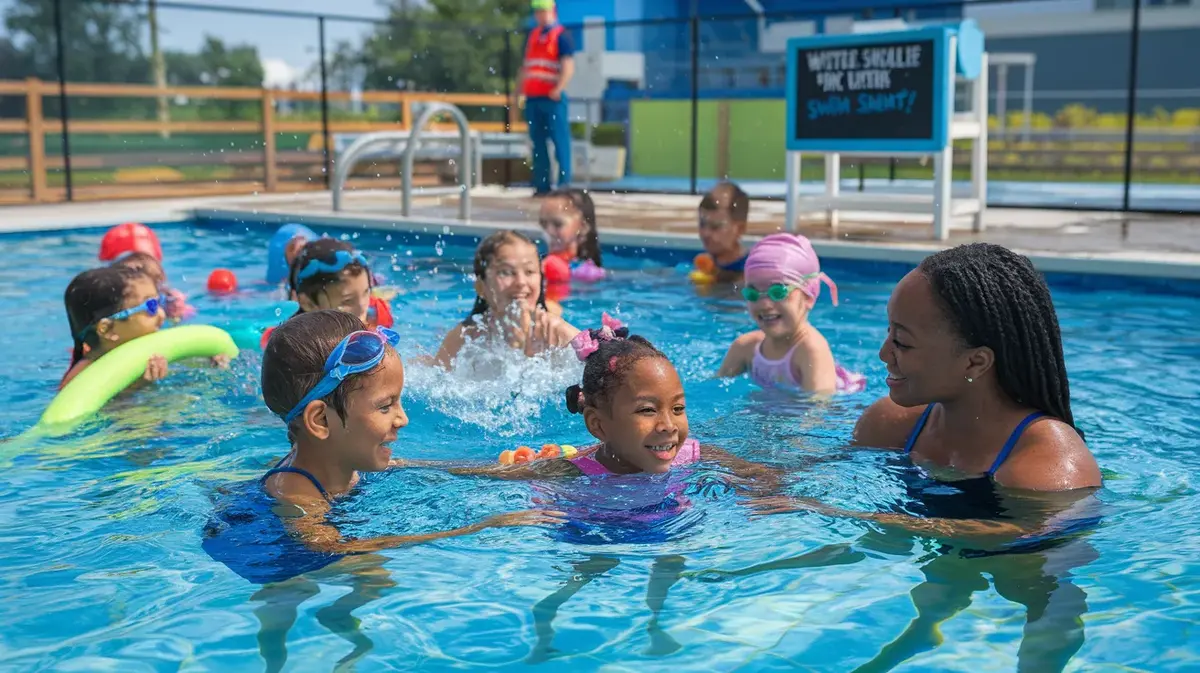
1 thought on “Teach Kids to Swim: Water Safety & Fun Lessons for Confident Little Swimmers”